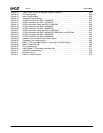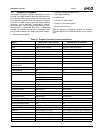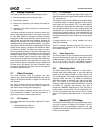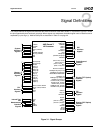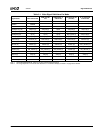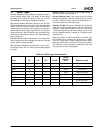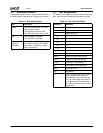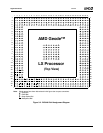
18 AMD Geode™ LX Processors Data Book
Architecture Overview
33234H
2.6 Display Controller
The Display Controller performs the following functions:
1) Retrieves graphics, video, and cursor data.
2) Serializes the streams.
3) Performs any necessary color lookups and output for-
matting.
4) Interfaces to the Video Processor for driving the dis-
play device(s).
The Display Controller consists of a memory retrieval sys-
tem for rasterized graphics data, a VGA, and a back-end fil-
ter. The AMD Geode LX processor’s Display Controller
corresponds to the Display Controller function found in the
AMD Geode GX processor with additional hardware for
graphics filter functions. The VGA provides full hardware
compatibility with the VGA graphics standard. The raster-
ized graphics and the VGA share a single display FIFO and
display refresh memory interface to the GeodeLink Mem-
ory Controller (GLMC). The VGA uses 8 bpp and syncs,
that are expanded to 24 bpp via the color lookup table, and
passes the information to the graphics filter for scaling and
interlaced display support. The stream is then passed to
the Video Processor, which is used for video overlay. The
Video Processor forwards this information to the DAC (Dig-
ital-to-Analog Converter), that generates the analog red,
green, and blue signals, and buffers the sync signals that
are then sent to the display. The Video Processor output
can also be rendered as YUV data, and can be output on
the Video Output Port (VOP).
2.7 Video Processor
The Video Processor mixes the graphics and video
streams, and outputs either digital RGB data to the internal
DACs or the flat panel interface, or digital YUV data via the
VOP interface.
The Video Processor delivers high-resolution and true-
color graphics. It can also overlay or blend a scaled true-
color video image on the graphic background.
The Video Processor interfaces with the CPU Core via a
GLIU master/slave interface. The Video Processor is a
slave only, as it has no memory requirements.
2.7.1 CRT Interface
The internal high performance DACs support CRT resolu-
tions up to:
— 1920x1440x32 bpp at 85 Hz
— 1600x1200x32 bpp at 100 Hz
2.7.2 TFT Controller
The TFT Controller converts the digital RGB output of a
Video Mixer block to the digital output suitable for driving a
TFT flat panel LCD.
The flat panel connects to the RGB port of the Video Mixer.
It interfaces directly to industry standard 18-bit or 24-bit
active matrix thin film transistor (TFT). The digital RGB or
video data that is supplied by the video logic is converted
into a suitable format to drive a wide range of panels with
variable bits. The LCD interface includes dithering logic to
increase the apparent number of colors displayed for use
on panels with less than 6 bits per color. The LCD interface
also supports automatic power sequencing of panel power
supplies.
It supports panels up to a 24-bit interface and up to
1600x1200 resolution.
The TFT Controller interfaces with the CPU Core via a
GLIU master/slave interface. The TFT Controller is both a
GLIU master and slave.
2.7.3 Video Output Port
The VOP receives YUV 4:4:4 encoded data from the Video
Processor and formats the data into a video stream that is
BT.656 compliant. Output from the VOP goes to either a
VIP or a TV encoder. The VOP is BT.656/601 compliant
since its output may go directly (or indirectly) to a display.
2.8 Video Input Port
The Video Input Port (VIP) receives 8- or 16-bit video or
ancillary data, 8-bit message data, or 8-bit raw video and
passes it to data buffers located in system memory. The
VIP is a DMA engine. The primary operational mode is as a
compliant VESA 2.0 slave. The VESA 2.0 specification
defines the protocol for receiving video, VBI, and ancillary
data. The addition of the message passing and data
streaming modes provides additional flexibility in receiving
non-VESA 2.0 compliant data streams. Input data is
packed into QWORDS, buffered into a FIFO, and sent to
system memory over the GLIU. The VIP masters the inter-
nal GLIU and transfers the data from the FIFO to system
memory. The maximum input data rate (8- or 16-bits) is 150
MHz.
2.9 GeodeLink™ PCI Bridge
The GeodeLink PCI Bridge (GLPCI) contains all the neces-
sary logic to support an external PCI interface. The PCI
interface is PCI v2.2 specification compliant. The logic
includes the PCI and GLIU interface control, read and write
FIFOs, and a PCI arbiter.



